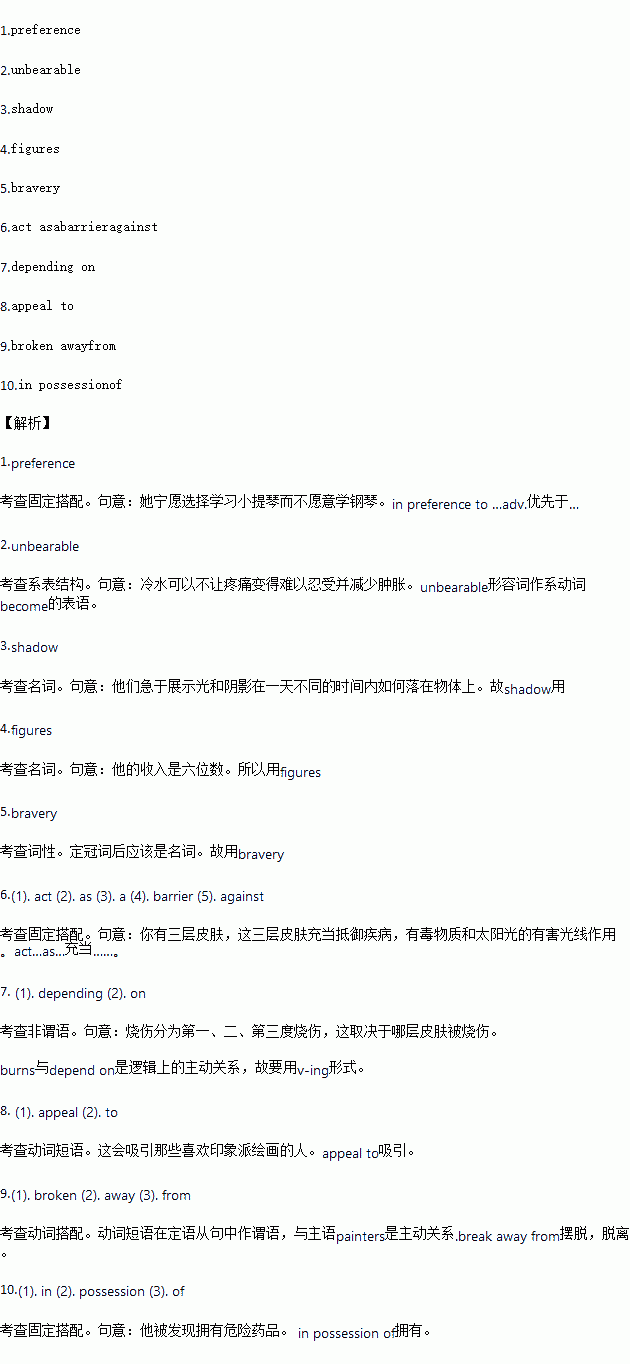题目内容
1.She chose to learn the violin in _________(prefer) to the piano.
2.The cool water prevents the pain becoming ____________(bear) and reduces swelling.
3.They were eager to show how light and __________(阴影)fell on objects at different times of day.
4.He has an income of six ___________(数字).
5.John was presented with his award at a ceremony which recognized the _________(brave) of ten people.
6.You have three layers of skin which ______ _______ _____ ______ _______(充当抵御的屏障)disease, poisons and the sun’s harmful rays.
7.Burns are called first, second or third degree burns, ________ ________(信赖,取决于)which layers of skin are burned.
8.It will _______ _______(吸引)those who love Impressionist paintings.
9.Among the painters who _________ _________ ________(挣脱;脱离)the traditional style of painting were the Impressionists, who lived and worked in Paris.
10.He was found ________ _________ ________(拥有)some dangerous drugs.
A group of cultural calendars, with creative designs, informative content and delicate printing, were hot sellers last year and now posting photos of the calendars has become a new fad on social networks. Many people posted photos of their cultural calendars with their comments to arouse memories of traditional knowledge. Though the cultural calendars are a return to traditions, designers are racking their brains to make the calendars appear more attractive.
| What’s black and white and fun all over? Penguins, of course! These friendly, odd-looking creatures have a universal appeal. Twelve vivid, full color photographs show us various species of penguins surviving in their harsh environment. The Penguins 2016 Wall Calendar features daily grids(格子) with ample room for notes and reminders. U.S. and international holidays are also included. |
| Most of the typeface(字体) for The Palace Museum’s Datebook came from the ancient copies of Kai calligraphy and Li calligraphy, as well as pictures of classic Chinese paintings and artworks. More than 50,000 volumes of it were sold on the November 11 Singles Day, and since then it has remained a best-seller among the art books on JD.com, an online marketplace. |
| The cover for The Red Chamber Dream Calendar was made using a special kind of paper with a red woven design, which symbolizes the joyous and prosperous new year. Inside the datebook, poems, ancient paintings from the classic novel, Dream of the Red Chamber, as well as the inclusion of traditional customs, festivals and solar terms make the datebook seem elegant and informative. |
| Calendar: Beauty of Chinese Characters, however, has 12 themes for the year and tells about the origin of Chinese characters, other interesting information about Hanzi, the name for the characters. By reading the whole book, one can gain a complete knowledge of Hanzi’s history. |
1.The underlined word “fad” in paragraph 1 is closest in meaning to “________”.
A. invention B. content
C. design D. fashion
2.If you are interested in conventional customs, which calendar should you refer to?
A. The Red Chamber Dream Calendar
B. The Palace Museum Datebook
C. Calendar: Beauty of Chinese Characters
D. The Penguins 2016 Wall Calendar
3.According to the description of The Palace Museum’s Datebook, ________.
A. you can find the information about the origin of Chinese characters
B. it has been and remains a best-seller on online marketplaces
C. ancient paintings and poems are included inside the datebook
D. you can appreciate ancient Chinese calligraphy in it


 a call. ____ ,her children couldn’t come to visit her. Worse still, Susan had ____ the mealtime in the hospital. She lay in bed, _____ and silent. Jenny’s daughter offered to buy her some food but she had no appetite ____ .
a call. ____ ,her children couldn’t come to visit her. Worse still, Susan had ____ the mealtime in the hospital. She lay in bed, _____ and silent. Jenny’s daughter offered to buy her some food but she had no appetite ____ .


